语言学导论-第9章Language & Culture
- 格式:ppt
- 大小:106.00 KB
- 文档页数:18
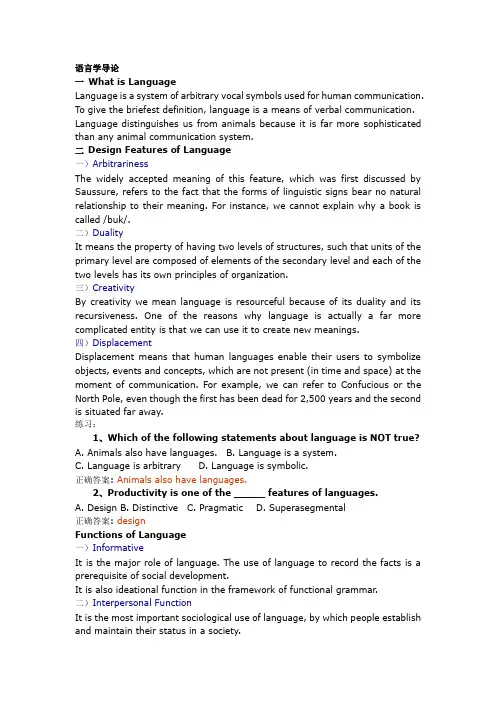
语言学导论一What is LanguageLanguage is a system of arbitrary vocal symbols used for human communication. To give the briefest definition, language is a means of verbal communication. Language distinguishes us from animals because it is far more sophisticated than any animal communication system.二Design Features of Language一)ArbitrarinessThe widely accepted meaning of this feature, which was first discussed by Saussure, refers to the fact that the forms of linguistic signs bear no natural relationship to their meaning. For instance, we cannot explain why a book is called /buk/.二)DualityIt means the property of having two levels of structures, such that units of the primary level are composed of elements of the secondary level and each of the two levels has its own principles of organization.三)CreativityBy creativity we mean language is resourceful because of its duality and its recursiveness. One of the reasons why language is actually a far more complicated entity is that we can use it to create new meanings.四)DisplacementDisplacement means that human languages enable their users to symbolize objects, events and concepts, which are not present (in time and space) at the moment of communication. For example, we can refer to Confucious or the North Pole, even though the first has been dead for 2,500 years and the second is situated far away.练习:1、Which of the following statements about language is NOT true?A. Animals also have languages.B. Language is a system.C. Language is arbitraryD. Language is symbolic.正确答案:Animals also have languages.2、Productivity is one of the _____ features of languages.A. DesignB. DistinctiveC. PragmaticD. Superasegmental正确答案:designFunctions of Language一)InformativeIt is the major role of language. The use of language to record the facts is a prerequisite of social development.It is also ideational function in the framework of functional grammar.二)Interpersonal FunctionIt is the most important sociological use of language, by which people establish and maintain their status in a society.Attached to the interpersonal function of language is its function of the expression of identity.三)PerformativeThis concept originates from the philosophical study of language presented by Austin and Searle, whose theory now forms the backbone of pragmatics.The performative function of language is primarily to change the social status of persons as in marriage ceremonies, the blessing of children and the naming of a ship at a launching ceremony. The kind of language employed in performative verbal acts is usually quite formal and even ritualized.四)Emotive FunctionThe emotive function of language is one of the most powerful uses of language because it is so crucial in changing the emotional status of an audience for or against someone or something. e.g. God, My, Damn it ......五)Phatic CommunionThe term originates from Malinowski's study of the function of language performed by Trobriand Islanders. It refers to the social interaction of language.We all use small, seemingly meaningless expressions such as Good morning, God bless you, Nice day to maintain a comfortable relationship between people. 六)Recreational FunctionNo one will deny the use of language for the sheer joy of using it such as baby's babbling or a chanter's chanting.七)Metalingual FunctionOur language can be used to talk about itself. For example, we can use the word "book" to talk about a book.What is Linguistics?Linguistics is a branch of science, which takes language as its object of investigation.Main Branches of Linguistics一)PhoneticsPhonetics studies speech sounds, including the production of speech, that is how speech sounds are actually made, transmitted and received, the sounds of speech, the description and the classification of speech sounds, words and connected speech, etc.二)PhonologyPhonology studies the rules governing the structure, distribution and sequencing of speech sounds and the shape of syllables. It deals with the sound systems of a language by treating phonemes as the point of departure.三)MorphologyMorphology is concerned with the internal organization of words. It studies the minimal units of meaning—morphemes and word-formation processes.四)SyntaxSyntax is about principles of forming and understanding correct English sentences.五)SemanticsSemantics examines how meaning is encoded in a language. It is not only concerned with meanings of words as lexical items, but also with levels of language below the word and above it, e.g. meaning of morphemes and sentences.六)PragmaticsPragmatics is the study of meaning in context. In other words, it is concerned with the way language is used to communicate rather than with the way language is structured.练习:1、Which branch of study cannot be included in the scope of Lingustics?A. AnthropologyB. PhoneticsC. PragmaticsD. Syntax正确答案:Anthropology2、______ is the study of the relationship between symbols and their interpreter.A. PragmaticsB. SemanticsC. SociolinguisticsD. Syntax正确答案:Pragmatics3、____ is concerned with the study of the actual use of language in communication.A. PragmaticsB. SemanticsC. SociolinguisticsD. Synchronic linguistics正确答案:Pragmatics4、Once the notion of _____ was taken into consideration, semantics spilled into pragmatics.A. ContentB. ContextC. FormD. Meaning正确答案:context5、_____ is the major concern of semantics.A. MeaningB. Phrase structure rulesC. Sentence structuresD. Words正确答案:MeaningMacrolinguistics一)PsycholinguisticsPsycholinguistics investigates the interrelation of language and mind, in processing and producing utterances and in language acquisition. The psychological constraints on the form of grammar are studied. It also studies language development in the child, biological foundations of language and the relationship between language and cognition.二)SociolinguisticsSociolinguistics is the study of the characteristics of language varieties, the characteristics of their function and the characteristics of their speakers as these three constantly interact and change within a speech community.三)Anthropological LinguisticsAnthropological linguistics deals with the emergence of language and also with the divergence of languages over thousands of years.四)Computational LinguisticsComputational linguistics is an interdisciplinary field which centers around the use of computers to process or produce human language.Important Distinctions in Linguistics一)Prescriptive & Descriptive(规定性研究与描述性研究)Do/Don't say X.People do/don't say X.The first are prescriptive commands and the second are descriptive statements. The distinction lies in prescribing how things ought to be and describing how things are. (规定性的语言学研究着重观察、总结语言中的“标准”,其目的通常是为了规定人们应该如何说话、写作,因而称为规定性研究;现代语言学诞生之前的大部分语法研究都属于此类。
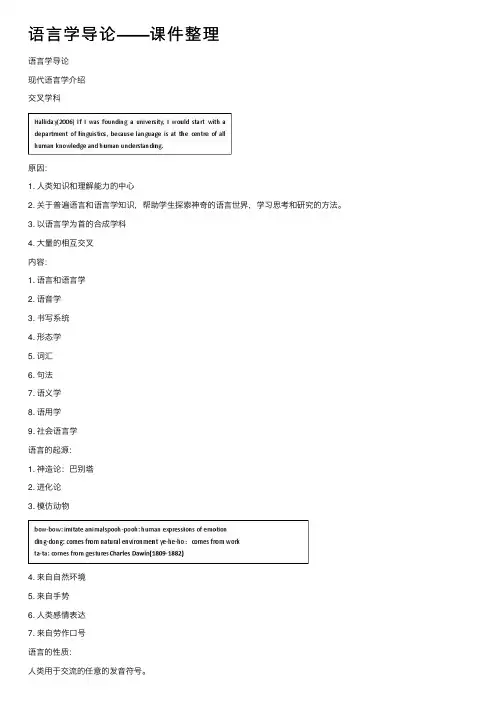
语⾔学导论——课件整理语⾔学导论现代语⾔学介绍交叉学科原因:1. ⼈类知识和理解能⼒的中⼼2. 关于普遍语⾔和语⾔学知识,帮助学⽣探索神奇的语⾔世界,学习思考和研究的⽅法。
3. 以语⾔学为⾸的合成学科4. ⼤量的相互交叉内容:1. 语⾔和语⾔学2. 语⾳学3. 书写系统4. 形态学5. 词汇6. 句法7. 语义学8. 语⽤学9. 社会语⾔学语⾔的起源:1. 神造论:巴别塔2. 进化论3. 模仿动物4. 来⾃⾃然环境5. 来⾃⼿势6. ⼈类感情表达7. 来⾃劳作⼝号语⾔的性质:⼈类⽤于交流的任意的发⾳符号。
⼀、语⾔是⼀种符号体系⼈们所指的物体与声⾳之间没有任何⾃然间的相似或联系。
社会习俗将词与物体、动作、观念联系起来,跨语⾔的社会习俗⼗分巨⼤。
1. 任意性2. 像似性理据:~语⾳学理据:。
拟声造字。
间接拟声构词(声⾳唤起动作)英语:PPT汉语:声象乎意;平声去声字意;声调不同意义改变,升调疑问,降调肯定;⼆、语⾔是⼀种交流的⼯具(思维)1)语⾔服从思维,是⼈类思想赖以表达的媒介或⼯具2)语⾔表达的思想具有可译性,不会⽤另⼀种语⾔来表达⽽损失其意义。
据说⼀种⼯具⼀经创造,它就独⽴于⼈甚⾄控制⼈和⼈的思维。
现在⼈服从语⾔。
现实的延伸取决于语⾔的发展。
语⾔制约着我们思考社会问题的⽅式。
……语⾔对思维的影响实例分析:1.特点:单⾳节字对应概念词影响:对仗⼯整,韵律节奏,表达模糊(上义词⽂化),统⼀辩证,同义反复思维极端,凑⾜⾳节识字重要所需要的能辨别意义的⾳节不多,不利于准确便捷的交际2.特点:双⾳节词3.特点:同义词影响:中国⽂化、政治和经济借以同⾳词⽽表现出特有的形式⽂化思维:诗歌,歇后语⽂化,谜语⽂化,⼴告⽂化,⼿机⽂化,外来词意译4.特点:形象思维(VS.抽象思维)影响:对事物的命名四字成语缺乏逻辑性三、语⾔是有系统的最基本的:声⾳与意义双重性语⾔的特征任意性线性离散性创造性(与双重性相关):低层:声⾳(⽆意义)⾼层:通过组合或重组的意义单元,可以组成⽆限的句⼦置换性(虚构)⽂化传递性语⾔分类1.遗传学分类(共同祖先—语系)2.类型分类(形态学的和句法结构)~形态结构:。

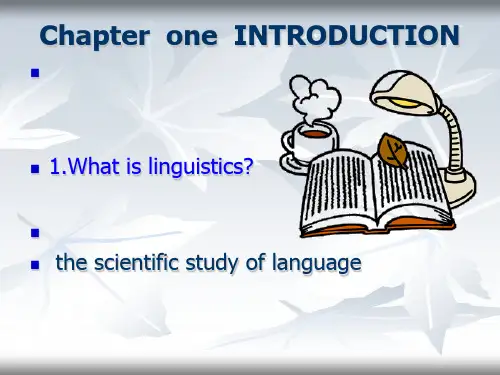
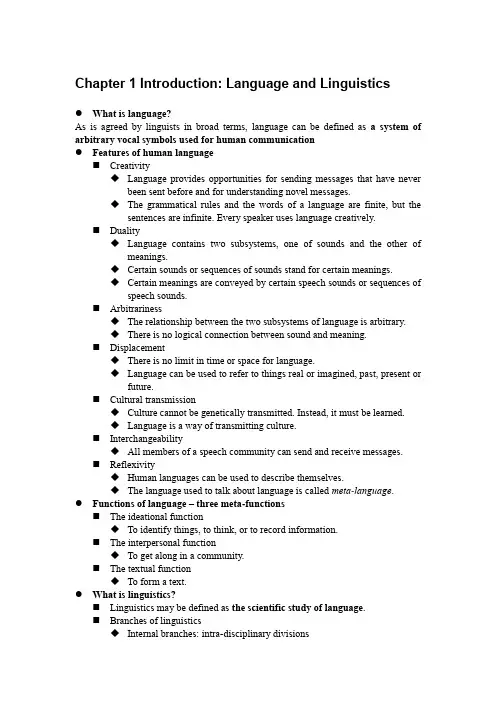
Chapter 1 Introduction: Language and Linguistics●What is language?As is agreed by linguists in broad terms, language can be defined as a system of arbitrary vocal symbols used for human communication●Features of human language⏹Creativity◆Language provides opportunities for sending messages that have neverbeen sent before and for understanding novel messages.◆The grammatical rules and the words of a language are finite, but thesentences are infinite. Every speaker uses language creatively.⏹Duality◆Language contains two subsystems, one of sounds and the other ofmeanings.◆Certain sounds or sequences of sounds stand for certain meanings.◆Certain meanings are conveyed by certain speech sounds or sequences ofspeech sounds.⏹Arbitrariness◆The relationship between the two subsystems of language is arbitrary.◆There is no logical connection between sound and meaning.⏹Displacement◆There is no limit in time or space for language.◆Language can be used to refer to things real or imagined, past, present orfuture.⏹Cultural transmission◆Culture cannot be genetically transmitted. Instead, it must be learned.◆Language is a way of transmitting culture.⏹Interchangeability◆All members of a speech community can send and receive messages.⏹Reflexivity◆Human languages can be used to describe themselves.◆The language used to talk about language is called meta-language.●Functions of language – three meta-functions⏹The ideational function◆To identify things, to think, or to record information.⏹The interpersonal function◆To get along in a community.⏹The textual function◆To form a text.●What is linguistics?⏹Linguistics may be defined as the scientific study of language.⏹Branches of linguistics◆Internal branches: intra-disciplinary divisions●Phonetics●Phonology●Morphology●Syntax●Semantics◆External branches: inter-disciplinary divisions●Pragmatics●Psycholinguistics●Sociolinguistics●Applied linguistics●Computational linguistics●Neurolinguistics⏹Modern linguistics began in the early 20th century. It founder is the Swissscholar, Ferdinand de Saussure.(索绪尔)Chapter 2 Phonetics●What is phonetics?Phonetics is termed as the study of speech sounds. (It studies how speech sounds are produced, transmitted and perceived.)●Description of speech sounds⏹Description of English consonants◆General feature: obstruction◆Criteria of consonant description●Places of articulation●Manners of articulation●V oicing of articulation◆Places of articulation●This refers to each point at which the air stream can be modified toproduce a sound.⏹Bilabial: [p] [b] [m] [w]⏹Labiodental: [f] [v]⏹Interdental: [ ] [❆]⏹Alveolar: [t] [d] [s] [z] [l] [n] [r]⏹Palatal: [☞] [✞] [t☞] [d✞] [j]⏹Velar: [k] [g] [☠]⏹Glottal: [h]◆Manners of articulation●This refers to how the air stream is modified, whether it iscompletely blocked or partially obstructed.⏹Stops: [p] [b] [t] [d] [k] [g]⏹Fricatives: [s] [z] [☞] [✞] [f] [v] [ ] [❆] [h]⏹Affricates: [t☞] [d✞]⏹Liquids: [l] [r]⏹Glides: [w] [j]⏹Nasals: [m] [n] [☠]◆V oicing of articulation●This refers to the vibrating of the vocal cords when sounds areproduced.⏹V oiced sounds⏹V oiceless soundsChapter 3 Phonology●What is phonology?Phonology is the study of sound patterns and sound systems of language.●Discovering phonemes⏹Contrastive distribution – phonemes◆If sounds appear in the same environment, they are said to be incontrastive distribution.◆Typical contrastive distribution of sounds is found in minimal pairs andminimal sets.● A minimal pair consists of two words that differ by only one soundin the same position.●Minimal sets are more than two words that are distinguished by onesegment in the same position.◆The overwhelming majority of the consonants and vowels represented bythe English phonetic alphabet are in contrastive distribution.◆Some sounds can hardly be found in contrastive distribution in English.However, these sounds are distinctive in terms of phonetic features.Therefore, they are separate phonemes.⏹Complementary distribution – allophones◆Sounds that are not found in the same position are said to be incomplementary distribution.◆If segments are in complementary distribution and share a number offeatures, they are allophones of the same phoneme.●Syllable structure⏹ A syllable is a phonological unit that is composed of one or more phonemes.⏹Every syllable has a nucleus, which is usually a vowel.⏹The nucleus may be preceded by one or more consonants called the onset andfollowed by one or more consonants called the coda.Chapter 4 Morphology●What is morphology?Morphology is defined as t he study of the internal structure and the formation of words.●Morphemes and allomorphs⏹The smallest meaningful unit of language is called a morpheme.⏹The different morphs of the same morpheme are called allomorphs.●Conclusion: classification of morphemes⏹Morphemes◆Free morphemes: can be used independently as a word◆Bound morphemes: are the morphemes which cannot be used as a word,they must be attached to the other morphemes.●Formation of new words⏹Derivation◆Derivation forms a word by adding an affix to a free morpheme.◆Since derivation can apply more than once, it is possible to create aderived word with a number of affixes. For example, if we add affixes tothe word friend, we can form befriend, friendly, unfriendly, friendliness,unfriendliness, etc. This process of adding more than one affix to a freemorpheme is termed complex derivation.◆Derivation does not apply freely to any word of a given category.Generally speaking, affixes cannot be added to morphemes of a differentlanguage origin.◆Derivation is also constrained by phonological factors.◆Some English suffixes also change the word stress.⏹Compounding◆Compounding is another common way to form words. It is thecombination of free morphemes.◆The majority of English compounds are the combination of words fromthe three classes – nouns, verbs and adjectives – and fall into the threeclasses.◆In compounds, the rightmost morpheme determines the part of speech ofthe word.◆The meaning of compounds is not always the sum of meaning of thecomponents.⏹Conversion◆Conversion is the process putting an existing word of one class intoanother class.◆Conversion is usually found in words containing one morpheme.⏹Clipping◆Clipping is a process that shortens a polysyllabic word by deleting one ormore syllables.◆Clipped words are initially used in spoken English on informaloccasions.◆Some clipped words have become widely accepted, and are used even informal styles. For example, the words bus (omnibus), vet (veterinarian),gym (gymnasium), fridge (refrigerator)and fax (facsimile)are rarelyused in their complete form.⏹Blending◆Blending is a process that creates new words by putting togethernon-morphemic parts of existing words. For example, smog(smoke +frog), brunch (a meal in the middle of morning, replacing both breakfastand lunch), motel(motor + hotel). There is also an interesting word inthe textbook for junior middle school students –“plike” (a kind ofmachine that is like both a plane and a bike).⏹Back-formation◆Back-formation is the process that creates a new word by dropping a realor supposed suffix. For example, the word televise is back-formed fromtelevision. Originally, the word television is formed by putting the prefixtele- (far) to the root vision (viewing). At the same time, there is a suffix–sion in English indicating nouns. Then people consider the –sion in theword television as that suffix and drop it to form the verb televise.⏹Acronyms and abbreviations◆Acronyms and abbreviations are formed by putting together the initialletters of all words in a phrase or title.◆Acronyms can be read as a word and are usually longer thanabbreviations, which are read letter by letter.◆This type of word formation is common in names of organizations andscientific terminology.⏹Eponyms◆Eponyms are words that originate from proper names of individuals orplaces. For example, the word sandwich is a common noun originatingfrom the fourth Earl of Sandwich, who put his food between two slicesof bread so that he could eat while gambling.⏹Coinage◆Coinage is a process of inventing words not based on existingmorphemes.◆This way of word formation is especially common in cases whereindustry requires a word for a new product. For example, Kodak andCoca-cola.Chapter 5 Syntax●What is syntax?Syntax is the study of the rules governing the way words are combined to form sentences in a language, or simply, the study of sentence formation.⏹Immediate constituent (IC) analysis◆Structural grammar is characterized by a top-down process of analysis.◆ A sentence is seen as a constituent structure. All the components of thesentences are its constituents. A sentence can be cut into sections. Eachsection is its immediate constituent. Then each section can be further cutinto constituents. This on-going cutting is termed immediate constituentanalysis.◆Examples:●Old men and women: old | men and women, old || men | and women●The ||| little || girl | speaks || French.◆In this way, sentence structure is analyzed not only horizontally but alsovertically. In other words, IC analysis can account for the linearity andthe hierarchy of sentence structure.●I will suggest | that this || in itself reflects ||| a particular ideology|||| about gender ||||| that deserves to be re-examined.◆Two advantages of IC analysis:●It can analyze some ambiguities.●It shows linearity and hierarchy of one sentence.●Transformational-generative (TG) grammar⏹Background and the goal of TG grammar◆Chomsky (1957) – grammar is the knowledge of native speakers.⏹Syntactic categories◆Noun Phrase (NP)◆Verb Phrase (VP)◆Sentence (S)◆Determiner (Det)◆Adjective (Adj)◆Pronoun (Pro)◆Verb (V)◆Auxiliary Verb (Aux)◆Prepositional Phrase (PP)◆Adverb (Adv)⏹Phrase structure (PS) rules◆S →NP VP(Det) (Adj) N◆NP →{Pro◆VP →(Aux) V (NP) (PP)◆PP →P NPChapter 6 Semantics●What is semantics?Semantics is defined as the study of meaning. More specifically, semantics is the study of the meaning of linguistic units, words and sentences in particular.●Lexical sense relations⏹Synonymy◆Synonyms are words which have different forms but similar meanings.●Dialectal synonyms –lift/elevator, flat/apartment●Synonyms of different styles –gentleman/guy●Synonyms of different registers –salt/sodium chloride●Synonyms differing in affective meaning –attract/seduce●Synonyms differing in collocation –beautiful/handsome,able/capable◆Synonyms are frequently used in speaking and writing as a cohesivedevice. In order to avoid repetition the writer/speaker needs to use asynonym to replace a word in the previous co-text when he/she wants tocontinue to address that idea. The synonyms together function to createcohesion of the text.⏹Antonymy◆Antonyms are words which are opposite in meaning.●Gradable antonyms – pairs of words opposite to each other, but thepositive of one word does not necessarily imply the negative of theother. For example, the words hot and cold are a pair of antonyms,but not hot does not necessarily mean cold, maybe warm, mild orcool. Therefore, this pair of antonyms is a pair of gradableantonyms.●Complementary antonyms –words opposite to each other and thepositive of one implies the negative of the other: alive/dead●Reversal (relational) antonyms – words that denote the same relationor process from one or the other direction: push/pull, up/down,teacher/student◆Antonymy is frequently utilized as a rhetorical resource in language use.Oxymoron and antithesis based on antonymy. Gradable antonyms maygive rise to fuzziness.⏹Homonymy◆Homonyms are words which have the same form, but differentmeanings.●Homographs – words which are identical in spelling, but different inmeaning and pronunciation: tear [♦☪☜] (v.)/tear [♦♓☜] (n.)●Homophones –words which are identical in pronunciation, butdifferent in spelling and meaning: see/sea●Full homonyms –words which are identical in spelling andpronunciation, but different in meaning: bear (v. to give birth to ababy/to stand)/bear (n. a kind of animal)◆Rhetorically, homonyms are often used as puns.⏹Polysemy◆ A polyseme is a word which has several related senses.◆Polysemy is based on the intuition of native speakers as well as theetymology or history of words.⏹Hyponymy◆Hyponymy is a relation of inclusion.◆Tiger, lion, elephant and dog are hyponyms of the word animal. Wordslike animal are called superordinates.◆This kind of vertical semantic relation links words in a hierarchicalwork.●Sentencial sense relations – semantic relations of sentences⏹Sentences may be related in sense. I will illustrate sense relations within andbetween sentences.◆Tautology: The bachelor is unmarried.◆Contradiction: The bachelor is married.◆Inconsistency: John is single./John is married.◆Synonymousness: John broke the glass./The glass was broken by John.◆Entailment: The meeting was chaired by a spinster./The meeting waschaired by a woman.◆Presupposition: Sam has returned the book./Sam borrowed the book.⏹These semantic relations are found within or between meaningful sentences.There are sentences which sound grammatical but meaningless. Thesesentences are said to be semantically anomalous. For example:◆Colourless green ideas sleep furiously.◆The pregnant bachelor killed some phonemes.Chapter 7 Pragmatics●What is pragmatics?Pragmatics can be defined as the analysis of meaning in context.●Speech acts⏹In linguistic communication, people do not merely exchange information.They actually do something through talking or writing in variouscircumstances. Actions performed via speaking are called speech acts.⏹Types of speech acts◆Locutionary speech act – the action of making the sentence◆Illocutionary speech act – the intentions◆Perlocutionary speech act – the effects◆Of these dimensions, the most important is the illocutionary act.●Cooperation and implicature⏹Conversational Implicature◆In our daily life, speakers and listeners involved in conversation aregenerally cooperating with each other. In other words, when people aretalking with each other, they must try to converse smoothly andsuccessfully. In accepting speakers’ pres uppositions, listeners have toassume that a speaker is not trying to mislead them. This sense ofcooperation is simply one in which people having a conversation are notnormally assumed to be trying to confuse, trick, or withhold relevantinformation from one another.◆However, in real communication, the intention of the speaker is often notthe literal meaning of what he or she says. The real intention implied inthe words is called conversational implicature. For example:[1]A: Can you tell me the time?B: Well, the milkman has come.◆In this little conversation, A is asking B about the time, but B is notanswering directly. That indicates that B may also not no the accuratetime, but through saying “the milkman has come”, he is in fact giving arough time. The answer B gives is related to the literal meaning of thewords, but is not merely that. That is often the case in communication.The theory of conversational implicature is for the purpose of explaininghow listeners infer the speakers’ intention through the words.◆The study of conversational implicature starts from Grice (1967), theAmerican philosopher. He thinks, in daily communication, people areobserving a set of basic rules of cooperating with each other so as tocommunicate effectively through conversation. He calls this set of rulesthe cooperative principle (CP) elaborated in four sub-principles(maxims), that is the cooperative principle.⏹The Cooperative Principle◆Make your conversational contribution such as is required, at the stage atwhich it occurs, by the accepted purpose or direction of the talkexchange in which you are engaged. The maxims are:●Quantity⏹Make your contribution as informative as is required (for thecurrent purposes of the exchange).⏹Do not make your contribution more informative than isrequired.●Quality – Try to make your contribution one that is true.⏹Do not say what you believe to be false.⏹Do not say that for which you lack adequate evidence.●Relation – Be relevant.●Manner – Be perspicuous.⏹Avoid obscurity of expression.⏹Avoid ambiguity.⏹Be brief (avoid unnecessary prolixity).⏹Be orderly.◆We assume that people are normally going to provide an appropriateamount of information, i.e. they are telling the relevant truth clearly. Thecooperative principle given by Grice is an idealized case ofcommunication.Chapter 11 Second Language Acquisition (SLA)●What is SLA?The term language acquisition refers to t he natural process of children’s language development.To summarize, second language acquisition(SLA) may be defined as the process by which a language other than the mother tongue is learnt in a natural setting or ina classroom.◆Contrastive analysis●Compare the target language with the mother tongue.◆Error analysis●Describing errors⏹Omission-He came into _ classroom with a book in _ hand.⏹Addition/wordy-My child goes to his school.⏹Selection-I hope/wish…⏹Disordering-I yesterday went to … (I, yesterday, went to …/I went to …yesterday)Chapter 12 Linguistics and Foreign Language Teaching (FLT)⏹Syllabus design and material development。
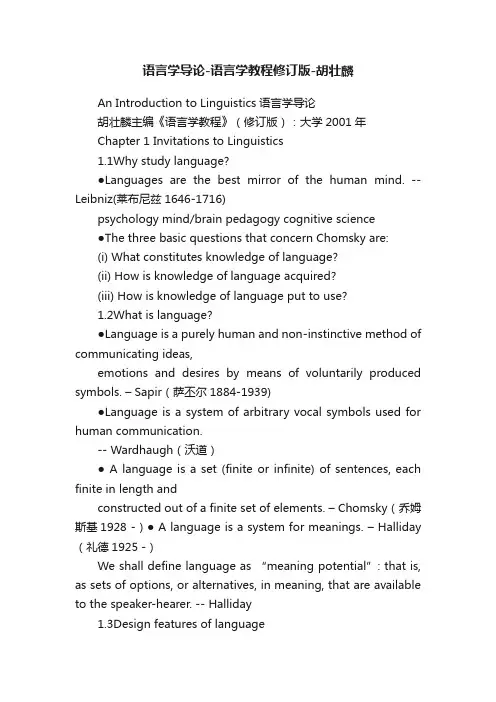
语言学导论-语言学教程修订版-胡壮麟An Introduction to Linguistics语言学导论胡壮麟主编《语言学教程》(修订版):大学2001年Chapter 1 Invitations to Linguistics1.1Why study language?●Languages are the best mirror of the human mind. --Leibniz(莱布尼兹1646-1716)psychology mind/brain pedagogy cognitive science●The three basic questions that concern Chomsky are:(i) What constitutes knowledge of language?(ii) How is knowledge of language acquired?(iii) How is knowledge of language put to use?1.2What is language?●Language is a purely human and non-instinctive method of communicating ideas,emotions and desires by means of voluntarily produced symbols. – Sapir(萨丕尔1884-1939)●Language is a system of arbitrary vocal symbols used for human communication.-- Wardhaugh(沃道)● A language is a set (finite or infinite) of sentences, each finite in length andconstructed out of a finite set of elements. – Chomsky(乔姆斯基1928 -)● A language is a system for meanings. – Halliday (礼德1925 -)We shall define language as “meaning potential”: that is, as sets of options, or alternatives, in meaning, that are available to the speaker-hearer. -- Halliday1.3Design features of language●Design features Concept introduced by C. F. Hockett in the 1960sof a set of key properties of language not shared or not known to be shared, as a set, with systems of communication in any other species. Their number and names vary from one account to another; but all include, as among the most important, the properties of duality, arbitrariness, and productivity.1.3.1Arbitrariness任意性: The property of language by which there is in general nonatural (i.e. logical) relation between the form of a single lexical unit and itsmeaning. 书book livre rose motivated 理据sheep cow moo moo quackoink bedroomWhat’s in a name? that which we ca ll a roseBy any other name would smell as sweet. – Shakespeare(莎士比亚1564-1616)名无固宜,约之以命,约定俗成谓之宜,异于约则谓之不宜。


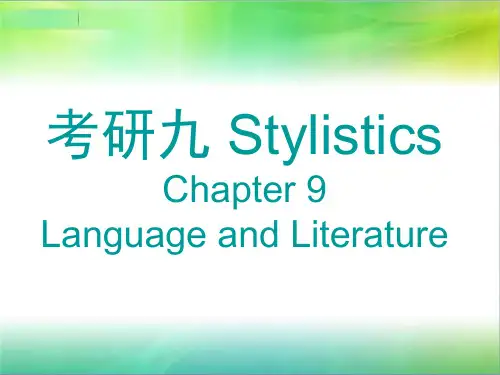
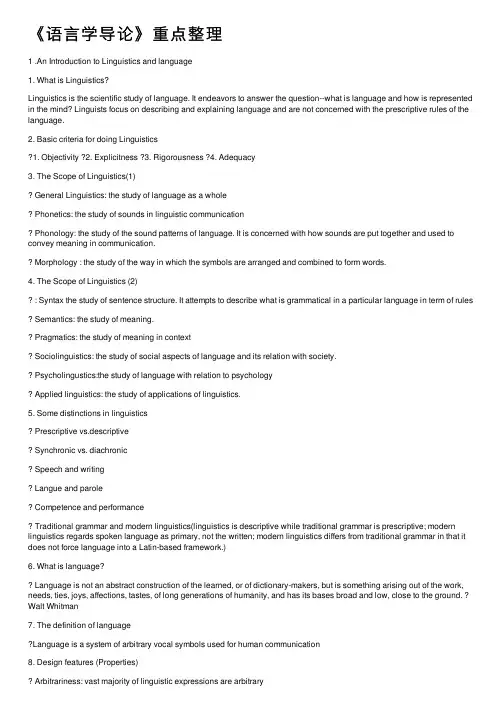
《语⾔学导论》重点整理1 .An Introduction to Linguistics and language1. What is Linguistics?Linguistics is the scientific study of language. It endeavors to answer the question--what is language and how is represented in the mind? Linguists focus on describing and explaining language and are not concerned with the prescriptive rules of the language.2. Basic criteria for doing Linguistics1. Objectivity2. Explicitness3. Rigorousness4. Adequacy3. The Scope of Linguistics(1)General Linguistics: the study of language as a wholePhonetics: the study of sounds in linguistic communicationPhonology: the study of the sound patterns of language. It is concerned with how sounds are put together and used to convey meaning in communication.Morphology : the study of the way in which the symbols are arranged and combined to form words.4. The Scope of Linguistics (2): Syntax the study of sentence structure. It attempts to describe what is grammatical in a particular language in term of rules Semantics: the study of meaning.Pragmatics: the study of meaning in contextSociolinguistics: the study of social aspects of language and its relation with society.Psycholingustics:the study of language with relation to psychologyApplied linguistics: the study of applications of linguistics.5. Some distinctions in linguisticsPrescriptive vs.descriptiveSynchronic vs. diachronicSpeech and writingLangue and paroleCompetence and performanceTraditional grammar and modern linguistics(linguistics is descriptive while traditional grammar is prescriptive; modern linguistics regards spoken language as primary, not the written; modern linguistics differs from traditional grammar in that it does not force language into a Latin-based framework.)6. What is language?Language is not an abstract construction of the learned, or of dictionary-makers, but is something arising out of the work, needs, ties, joys, affections, tastes, of long generations of humanity, and has its bases broad and low, close to the ground. ? Walt Whitman7. The definition of languageLanguage is a system of arbitrary vocal symbols used for human communication8. Design features (Properties)Arbitrariness: vast majority of linguistic expressions are arbitraryProductivity: creativity or open-endednessDuality: double articulation(sounds and meanings)Displacement: eg. Santa Claus, Superman, dragonCultural transmission: meme, memics(Discreteness:the sounds used in language are meaningfully distinct. Eg. pack, back)9. AssignmentsComment on the definition of language.Summarize the design features of language.What is your understanding of synchronic study of language2.Chapter 2 Phonetics and phonology1. Phonetics: the sounds of languageThree branches of phoneticsArticulatory Phonetics发⾳语⾳学: the production of speech sounds.Auditory Phonetics听觉语⾳学: the study of the perception of speech soundsAcoustic Phonetics声学语⾳学: the study of the physical production and transmission of speech sounds.2. Organs of speech: 1.The pharyngeal cavity喉腔2.The oral cavity⼝腔3.The nasal cavity⿐腔3. Two kinds of transcriptionBroad transcription宽式标⾳: transcription with letter-symbolsNarrow transcription窄式标⾳: transcription with letter-symbols and the diacritics4. Classification of English consonants5. Classification of English vowels6. Phonology : the sound patterns of languageDifference Phone, phoneme, allophonePhonemic contrast, complementary distribution, minimal pair7. Phones, phonemes, and allophonesPhonology is the study of sound patterns of language( i.e. how sounds are arranged to form meaningful units) and the function of each sound. It reveals what are the possible combinations of sounds in a language and explains why certain words take the form they do.8. Phone ⾳素phone: the smallest perceptible discrete segment of sound in a stream of speechi) phonetic unit ii) not distinctive of meaning iii) physical as heard or produced iv) marked with [ ]9. Phoneme ⾳位the minimal unit in the sound system of a language. With phonemes, we establish the patterns of organization within the infinitely large number of sounds. Each language can be shown to operate with a relatively small number of phonemes (15-80). No two languages have the same phonemic system.10. Phoneme ⾳位i) phonological unit ii) distinctive of meaning iii) abstract, not physical iv) marked with / /.11.Three requirements for identifying minimal pairs:1) different in meaning; 2) only one phoneme different; 3) the different phonemes occur in the same phonetic environment. Minimal set: pat, mat, bat, fat, cat, hat, etc.11. Allophone ⾳位变体: phonic variants/realizations of a phoneme12. Phonological rules:Phonological patterning is rule-governed. [blik] and [kilb], though not found in English, can be possible combinations, while [kbil] or [lkib] cannot. Sequential rules are those that account for the combination of sounds in a particular language. They are language-specific, as in thefollowing cases:* [tlait] [iltrit]13.Sequential ruleIf three consonants should cluster together at the beginning of a word, the combination should follow the order/sequence below:a. The first phoneme must be /s/b. The second phoneme must be /p/, /t/ or /k/c. The third phoneme must be /l/, /r/, or /w/. spring, string, squirrel, split, screen14. Assimilation ruleA sound may change by assimilating/copying a feature of a sequential/neighboring sound, e.g. impossible, irresistible, illegal [in-]Question: What other examples?sink /since pan cake sun glasses five past seven has to15. Deletion ruleA sound may be deleted even though it may be orthographically represented.16.Stress, tone, and intonationSuprasegmental (超切分)phonology Suprasegmental phonemes:stress, tone and intonation17.Stress重⾳Word stress/sentence stress Primary stress/secondary stressStress of compounds: ‵blackbird / black ‵bird; ‵greenhouse / green ‵ houseSentence stress: Depending on the relative importance of the words; contrastive stress18. Tone (声调)Different rates of vibration produce different frequencies, which are termed as different pitches. Pitch variations are distinctive of meaning.In some languages like Chinese, pitch variations are called tones. Languages using tones are tone languages.19. Intonation(语调)When pitch, stress and length variations are tied to the sentence, they combine to become known as intonation.Three major types of English intonation: a. falling tone/tune b. rising tone/tune c. fall-rise tone/tune20. Assignments:Difference between phonetics and phonologyPhone, phoneme, allophonePhonemic contrast, complementary distribution, minimal pair3. Morphology(词法)1. Morphology is the study of word formation and structure. It studies how words are put together from their smaller parts and the rules governing this process.2. Two kinds of words1. Open class words: content words .e.g. nouns, verbs, adjectives and adverbs2. Closed class words: grammatical words or functional words. E.g. conjunctions, prepositions, articles and pronouns Words can be related to other words, e.g. "happy" — "unhappy".The rules that relate such sets of words are called Word Formation Rules. Thus, the morphology containsfundamental elements – morphemes rules of combination -- Word Formation Rules4. MorphemesThe elements that are combining to form words are called morphemes. A morpheme is the smallest unit of meaning you can have in a language.we know three things about every morpheme:1. its meaning2. its form (the sounds that make it up)3. a rule of combination (put it before/after/inside the stem)5. A case: Unhappy Happier unhappier6. Bound and Free Morphemes" In the word doors" there are two morphemes: "door" and "-s".The morpheme "door" can be used by itself, so it is called a FREE morpheme.But the morpheme "s" cannot be used by itself: ? "How many doors did you shut?" "More than one." OK "s" Not OK Therefore, "-s" is called a BOUND morpheme.7. AffixesMorphemes added to free forms to make other free forms are called affixes. There are four principle kinds of affixes:1. prefixes (at beginning) — "un-" in "unable"2. suffixes (at end) — "-ed" in "walked"3. circumfixes (at both ends) — "en--en" in "enlighten" (These always seem to consist ofotherwise attested independent prefixes and suffixes.)4. infixes (in the middle) -- "-bloody-" in "inbloody- credible"8.Derivational morphemesDerivational morphemes may or may not change the category, or grammatical class of words.E.g. Noun--- Adjective affection + ate alcohol+ ic9. Inflectional MorphologyMorphology that interacts with syntax (sentence structure) is called INFLECTIONAL MORPHOLOGY Some examples are: ? person? number? gender ? noun class ? case ? tenseInflectional morphemes never change the category. Inflectional morphemes do not change the "core" meaning of the word. Inflectional morphemes usually occur "outside" derivational ones. 10. A Rule for Forming some English Words 11. Compounds12. Other ways of Forming Words13. Word-formation:the creation of new words on the basis of existing structural devices in the language derivation compounding derivational affixation clipping, abbreviation, acronyms conversion* affixation * coinage: Ford, Kodak* compounding/composition: hot-line, keep-fit* conversion /functional shift : knee, cool, trigger, brake* derivation: alcoholic, affectionate* back-formation:edit, babysit, massproduce, laze* blending: smog, motel, globesity* shortening (clipped words, acronym) * borrowing: tea, algebra15. Compare the following derived words: in how far do they differ? Lab OED16. Compare the following derived words: in how far do they differ?lab babysit (from: babysitter)17. Compare the following derived words: in how far do they differ? institution-al skin-deep18. Compare the following derived words: in how far do they differ?to strength-en to house (e.g. this building houses 500 families)19. AssignmentsDistinguish the following terms: Open class words and closed class wordsBound morpheme and free morphemeInflectional morpheme and derivational morpheme List some rules of word formation 4. syntax1. Syntax is a branch of linguistics that studies how words are combined to form sentences and the rules that govern the formation of sentences.2. Syntactic rulesHow do we COMBINE WORDS to make SENTENCES? Syntax uses trees (just as in morphology) but the trees are built on WORDS instead of morphemes. Words are the fundamental units of sentences. The laws of combination for words are the syntactic rules.3. Sentence StructureWe know that there is structure in sentences separate from the meaning of the sentence because of the difference between "well formed nonsense" (1) and "total gibberish" (2) :(1) Colorless green ideas sleep furiously. (2) Green sleep furiously ideas colorless.Which sounds better ?4. Word-level categoriesMajor lexical categoriesN( Noun) book, boy V(Verb) run, buy A(Adjective) happy, heavyP (Preposition) about, in Minor lexical categories Det (determiner) the, a thisDeg (Degree word) quite, very Qual (Qualifier) often, always Aux(Auxiliary) must, should Con (Conjunction) and, but 5. Three criteria for judging the word’s categories1.meaning Noun—entity2.inflection -ed, -s3.distribution the girl Det+ N6. Phrase categoriesPhrases are constructed out of a "head" plus other material into:Noun Phrase (NP) Verb Phrase (VP) Adjective Phrase (AP) Prepositional Phrase (PP)7. Head, specifier, complementHead: the word around which a phrase is formedSpecifier: the words on the left side of the headscomplement: the words on the right side of the headsE.g. a touching story about a sentimental girl8. Phrase Structure RulesNP → (Det)N (PP) ? VP → (Qual) V ( NP) ? AP → (Deg)A (PP) ? PP → (Deg) P (NP)9. XP rule X= N, V, A or P XP →(specifier) X (complement)10. X – theory XP →(specifier) X X - → X(complement)11. Co-ordination rules X → X Con X12. XP rule (revised): XP →(specifier) X (complement ) Matrix clauseComplement phrase (CP) Complement clause Complementizers (Cs)13. ModifierAP PP AdvP The expanded XP rules XP →(spec)(Mod) X (complement*)(Mod)14. The S ruleS NP VPDet N V P Det N| | | | | |The cat is on the mat15. Transformational RulesOnce we have built a basic tree, we then might want to change it, for example to turn it into a question.1. John is going to school.2. Is John going to school?What happened between (1) and (2)? "Is" moved to the front. How did we make the yes/no question? What change did we make?16.Deep structure and surface structure:Deep structure is a level of syntactic representation that results from insertion of lexical items into the tree structure generated by the phrase structure rules.Surface structure is a level of syntactic representation that results from the application of whatever transformations are needed to yield the final syntactic form of the sentence.17. The organization of the syntactic componentThe XP ruleDeep structuretransformationsSurface structure18. Wh MovementMove the wh phrase to the beginning of the sentenceMove a wh phrase to the specifier position under CP19. Word OrderRecall that languages can choose the order of the constituents in a phrase structure rule. ? English: PP → P NP ? Japanese: PP → NP P20. SVOWe can say that the overall word-order in a simple sentence is Subject-Verb-Object or SVO.There are two choices for each rule:1. Sentence: S → NP VP S → VP NP2. Verb Phrase: VP → V NP VP → NP V21. AssignmentsDraw two possible trees for the sentence “The boy saw the man with the telescope. ”5. Semantics1. Semantics is the study of meaning.2. The Meanings of MeaningEveryday use and ambiguity of the word mean(ing)(1) Daddy, what does 'unique' mean? (2) When Mary talks about "her ex" she means me.(3) 'Purchase' means the same as 'buy'. (4) Gwailou means "foreign devil".(5) When he drinks it means he's depressed. (6) I didn't mean to hurt you.3. Ogden and Richards' The Meaning of Meaning (1923)sixteen different meanings of the words "mean/meaning" were distinguished. Here are some of them:John means to write. 'intends’A green light means go. 'indicates' Health means everything. 'has importance'His look was full of meaning. 'special import'What is the meaning of life? 'point, purpose'What does 'capitalist' mean to you? 'convey'What does ‘cornea‘(⾓膜)mean? 'refer to in the world'4. What does meaning mean in linguistics?It is the last kind of use that comes closest to the focus of linguistic semantics. In modern linguistics, the meaning is studied by making detailed analyses of the way words and sentences are used in specific contexts ("meaning" is not some kind of "entity" separate from language - any more than measures such as "height" or "length" have some kind of independent existence). This is an approach shared by a number of philosophers and psychologists. Ludwig Wittgenstein (1889- 1951), in particular, stressed its importance in his dictum: "The meaning of a word is its use in the language."5. 4 views concerning the study of meaningThe naming theory The conceptual theory Contextualism behaviorism6. The naming theoryPlato Words are names or labels for things.Limitations of the theory: it can be applicable to nouns only, but verbs, adjectives, and adverbs are not names or labels; imaginary things like “dragon”;abstract nouns like “joy”7. The conceptual theoryOgden & Richards' TriangleTHOUGHT (concepts, images, schemas)/ \(Sense) / \/ \(language) WORDS - - - - - - - - WORLD(things, situations)(Reference)Note: (i) Reference as an indirect relation(ii) Sense as a psychological notionWhat is the link between the language and concept?8. ContextualismLudwig Wittgenstein Malinowski J.R.Firth2 kinds of contexts: the situational context and the linguistic context9. BehaviorismBloomfield 1926, 1935 Behaviorism vs. mentalismHuman and animal behaviorStimulus and responseS -> r ... s -> R Jack and Jill10. Lexical meaningSense and referenceSense refers to the meaning of a Noun Phrase which determines its referent;Reference refers to that part of meaning of a Noun Phrase which is its referent.Sense is abstract and de-contextualized;Reference is concrete and contextualized.11. sense relations between words1.synonymy2.polysemy3.homonymy4.hyponymy5.antonymy11.1. synonymytwo words, same meaning never complete; tendency toward divergence,e.g small - little, but cf. small change and little sistera) dialectal synonymsb) stylistic synonymsc) synonyms that differ in their emotive or evaluative meaningd) collocational synonymse) semantically different synonyms11.2. polysemyone word, many meaningseye 'organ of sight', 'center of hurricane' , 'hole in needle'11.3.homonymydifferent words, same soundbear 'carry' bear 'furry creature' bare 'naked'cf. Homonymy, Homography: different words, same spelling bow 'knotted ribbon' bow 'front of ship'11.4.hyponymysuperordinate (hyponym) to subordinate Also: co-hyponymsProblematic superordinates:aunt - uncle > none sweet - sour - bitter > Tastes , but no Adj chair - sofa - couch > ? sitting furniture (Sitzm?bel) 11.5. antonymy(1) Gradable (scalar) antonyms: cold. . hot(2) Complementary antonyms: dead - alive(3) Relational opposites: teach - learn husband - wife12. six sense relations between sentencesa) X is synonymous with Yb) X is inconsistent with Yc) X entails Y (Y is an entailment of X)d) X presupposes Y (Y is a prerequisite of X)e) X is a contradiction?f) X is semantically anomalous?13. Analysis of meaningComponential analysisPredication analysisgrammatical meaningsemantic meaning13.1 Componential analysisFeatures in Semantic Theoryman = [+human] [+adult] [+male]woman = [+human] [+adult] [+female]girl = [+human] [-adult] [+female]boy = [+human] [-adult] [+male]stool = [+sitting] [+legs] [-back] [-arms] [+single person]chair = [+sitting] [+legs] [+back] [+/- arms] [+single person]sofa = [+sitting] [+/-legs] [+back] [+arms] [-single person] etccow = [+bovine] [+adult] [+female]ewe = [+ovine] [+adult] [+female] bull = [+bovine] [+adult] [+male]ram = [+ovine] [+adult] [+male] calf = [+bovine] [- adult]lamb = [+ovine] [-adult]But should calf = [+/-female] [+/-male] or simply unspecified?And what about: steer? = [+bovine] [+adult] [-male] [-female]13.2Predication analysisIt is proposed by G. Leech. In his framework of analysis, the basic unit is called predication, which is the abstraction of the meaning of a sentence. A predication consists of arguments and predicate. An argument is a logical participant in a predication. A predicate is something said about an argument or it states the logical relation linking the arguments in a sentence.14.Interdisciplinary nature of semantics (1)philosophy: definitions, truth, logiclinguistics: lexical, grammatical meaning; structural ambiguitypsychology: concepts, categorization, learninglaw: interpretation, entailment translation: translatability, paraphrasecomputer science: processing and representation of information15. Interdisciplinary nature of semantics(2)musicology: musical meaning (Joseph Swain: Musical Languages, 1997)anthropology: cultural meaning, relativityliterary criticism: interpretation, ambiguity, metaphorreligion (Anna Wierzbicka, What did Jesus mean?, 2001)16. Assignments:Summarize the four approaches to the studies on meaning.Specify the five major sense relations1.synonymy2.polysemy3.homonymy4.hyponymy5.antonymyDefine the following terms: componential analysis Predication analysis6 Pragmatics1. Pragmatics is the study of meaning in context2. Contextualist viewLudwig WittgensteinMalinowskiJ.R.Firth2 kinds of contexts: the situational context and the linguistic context3. Some issues in PragmaticsDeixis指⽰ Speech acts⾔语⾏为 Indirect language间接语⾔Conversation会话 Politeness礼貌 Cross-cultural communication跨⽂化交际Presupposition预设4. Pragmatics and Semanticsa There is continuum between Semantics (things that are true by theDEFINITIONS and RULES) and Pragrmatics (things that are true by virtue of the REAL WORLD Complementarism: semantics studies meaning in the abstract; pragmatics studies meaning in the context/use.5. Consider the following sentences:The rock ate my lunch. Semantically false, because "eat" requires anANIMATE subject.The giraffe ate the hyena. Grey area, does SEMANTICS include the concept VEGETARIANThe giraffe ate one hundred pounds of grass today.Pragmatics, how much DOES a giraffe eat in a day?6. ContextAccording to Firth, context includes the relevant features of participants: persons, personalities, the verbal and non-verbal action of the participants, the relevant objects and the effect of the verbal action. Hymes’ notion of context includes addressor, addressee, topic, setting, channel, code, message form, event, key and purpose.Shared knowledge7. Sentence meaning vs. utterance meaningSentence is often studied as the abstract, intrinsic property of the sentence itself in terms of predication. Utterance is the issuance in an actual context.The meaning of a sentence is abstract and decontextualized,while the meaning of an utterance is concrete and contextdependent.8. Speech Act TheoryAustin noticed that some sentences are special in that they DO things. One class is PERFORMATIVES. When spoken such sentences do the work:I (hereby) declare the fair open. ("hereby" is a good diagnostic of performatives)Performatives⾏事: Performatives were sentences that did not state a fact or describe a state, and were not verifiable. Constatives⾔事: constatives were statements that either state or describe, and were thusverifiable9. Three kinds of actsLocutionary act⾔内⾏为: locutionary act is the act of uttering words, phrases, clauses. It is the act of conveying literal meaning by means of syntax, lexicon and phonology.Illocutionary act⾔外⾏为: an illocutionary act is the act of expressing the speaker’s intention. It is an act performed in saying something.Perlocutionary act⾔后⾏为: perlocutionary act is the act performed by saying something. 10. Searle’s classification of speech actsRepresentatives: stating or describing, saying what the speaker believes to be true;Directives: trying to get the hearer to do something;Commissives: committing the speaker himself to future course of action;Expressives: expressing feelings or attitude towards an existing state;Declarations: bringing about immediate changes by saying something11. Principle of ConversationGrice discovered a number of conversational maxims (rules) that people generally obey.Two of them are: ? Be cooperative ? Be relevantThe following discourse represents a failure of cooperation:A: Do you know what time it isB: Yes.Or, if you know for sure that you're leaving on Tuesday it's misleading to say: "I'm leaving on Monday or Tuesday."12. Four maximsThe maxim of quantity The maxim of qualityThe maxim of relation The maxim of manner13. Conversational Implicatureconversational implicature: Conversational implicature occurs only when the maximsof Cooperative Principle are “flouted”. A: Do you know where Mr. X lives?B: Somewhere in the southern suburbs of the city.(said when it is known to both A and B that B has Mr. X’s address.)A: Would you like to come to our party tonight?B: I’m afraid I’m not feeling so well today.A: The hostess is an awful bore. Don’t you think?B: The roses in the garden are beautiful, aren’t they?(said when it is known to both A and B that it is entirely possible for B to make a comment on the hostess)A: Shall we get something for the kids?B: yes. But I veto I-C-E-C-R-E-A-M.(said when it is known to both A and B that B has no difficulty in pronouncing the word“ice-cream”).14. Leech’s Politeness PrincipleTact maxim Generosity maxim Approbation maximModesty maxim Agreement maxim Sympathy maxim15. The 6 maxims of Leech’s PPtact generosityapprobation modestyagreementsympathy16. Tact Maxim:1. Minimize cost to other 2.Maximize benefit to other Generosity Maxim:1. Minimize benefit to self 2. Maximize cost to self Approbation Maxim: 1. Minimize dispraise of other 2. Maximize praise of other Modesty Maxim:1. Minimize praise of self 2. Maximize dispraise of self17. Agreement Maxim: 1.Minimize disagreement between self and other2.Maximize agreement between self and otherSympathy Maxim: 1. Minimize antipathy between self and other2. Maximize sympathy between self and other18. Politeness scale: DirectnessdirectCould you possibly answer the phone?Would you mind answering the phone?Can you answer the phone?Will you answer the phone?I want you to answer the phone.Answer the phone.indirect19. Politeness scale: Cost – benefitbenefitHave another sandwich.Enjoy your holiday.Look at that.Sit down.Hand me the newspaper.Peel these potatoes.Cost20. PresuppositionsStatements or questions that presuppose a related sentence. "Leading" questions or statements. "When did you stop beating your donkey?" presupposes:You stopped beating your donkey.You did beat your donkey.You beat something.You have a donkey...."I'll have some more coffee." presupposes that you have already had some.21. assignmentsSpeech act theorycoperative principleconversational implicature7. Language Change1. ReviewPrescriptive vs.descriptive (Chapter 1)The definition of language: Language is a system of arbitrary vocal symbols used for human communication (Chapter 1) Word formation: affixation, composition, conversion, back formation, blend, shortening , coinage (Chapter 3) Contextualism (Chapter 5) Context (Chapter 6)2. All languages change through timeLanguages change in the phonology, morphology, syntax, lexicon and semantic components of the grammar.3. The changes of language at different levels (1)Sound changeMorphological and syntactic changea) change in “agreement” ruleb) change in negation rulec) process of simplificationd) loss of inflections4. The changes of language at different levels (2)Vocabulary changea) addition of new words(coinage, clipped words, blending, acronyms, backformation, functional shift, borrowing)b) loss of wordsc) changes in the meaning of words (widening of meaning, narrowing of meaning,meaning shift)5. Some recent trendsMoving towards greater informalityThe influence of American EnglishThe influence of science and technologya) space travel b) computer and internet language c) ecology6. Causes of language changea) The rapid development of science and technology has led to the creation of many new words: fax, laser, telecomb) As more and more women have taken up activities formerly reserved for men, more neutral job titles have been created: chairman-chairperson, fireman-fire fighter.c) The way children acquire the language provides a basic cause of change.d) “economy of memory ” and “theory of least effort”. foe/foes, cow/cows (kine)cheap-cheaplye) other factors, e.g. elaboration of grammar7. SummaryThe linguistic change is complex.The linguistic change is gradual.The exact reasons for language change are still elusive and need to be further investigated. 8. Assignments1. Illustrate the vocabulary change with examples.2. What are the possible causes of language change?8. Language and Society1. The relatedness between language and societyLanguage is used to establish and maintain social relationship.The kind of language the users choose is in part determined by his/her social background.Language is closely related to the structure of the society in which it is used, and the evaluation of a linguistic form is entirely social.2. Speech communityFor general linguists, a speech community is defined as a group of people who form a community and share the same language or a particular variety of a language.。
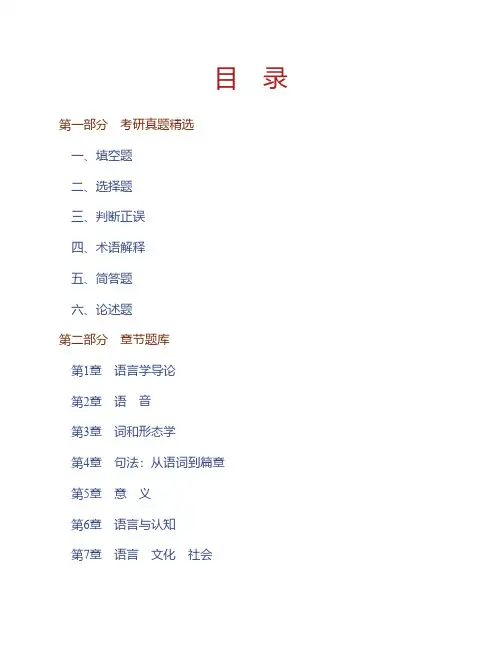
语言学导论课外补充练习(1)language1.State the nature of language briefly with examples.2.Why is it said that the language system is unique to human beings?3.What are the characteristics of human language?4.What are the social functions of language?5.Do animals other than humans have their own languages?6.Exemplify how animals communicate with each other.7.Can language be viewed only as a system of communication? Why not?8.How did language come into being? What is the relationship between the originof language and the origin of human beings?9.Rewrite each of the following lists of words into natural order.(1)Five /the /fresh /potatoes(2)Pretty /American /girls /the two(3)Airlines /brand /France-made /new /the two(4)Fashions /Chinese /the /latest /three(5)Beginning /hardworking /two /the /workers10.Fill in the blanks with the proper words.(1)_______ function means language can be used to “do” things.(2)_______ function means the use of language to reveal something about the feelings and attitudes of the speaker.(3)Most imperative sentences are associated with _______ function.(4)The sentence “What’s it like?” shows ______ function.(5)Greetings shows _______ function.(6)“We are most grateful for this.” shows______ function.(7)Propaganda shows ________ function.(8)________ refers to contexts removed from the immediate of the speaker.(9)For________, reference is not the only, not even the primary goal of communication.(10)Halliday’s metafunctions include ________, ___________, _____________.(11)Linguistics should include at least five parameters:_________ __________ ___________ ____________ _________________..11.Say the following are true or false. If it is false correct it(1)Language distinguishes us from animals because it is far more sophisticated than any animals communication system.(2)There is not a certain degree of correspondence between the sequence of clauses and the actual happenings.(3)The theories discussed in the textbook about the origins of language are not at most a speculation.(4)The definition,“ Language is a tool for human communication.” has no problem.(5)The definition, “language is a set of rules”, tells nothing about its functions.(6)Hall, like Sapir, treats language as a purely human institution.(7)Chomsky’s definition about language is the same as Sapir’s.语言学课外单元补充习题答案Language(Exercise 1)1. State the nature of language briefly with examples.Answer: modern linguists have proposed various definitions of language such as: Language is “a purely human and non-instinctive method of communicating ideas, emotion s and desires by means of voluntarily produced symbols.” (Sapir, 1921) Language is “the institution whereby humans communicate and interact with each other by means of habitually used oral-auditory arbitrary symbols.” (Hall, 1968) Language is “a set (fin ite or infinite) of sentences, each finite in length and constructed out of a finite set of elements.” (Chomsky, 1957)“语言是人跟人互通信息,用发音器官发出来的,成系统的行为的方式。
语言学概论习题导论一、填空:1.语言学是研究语言的科学,(语言)是语言学的研究对象。
语言学的基本任务是研究(语言)的规律,使人们懂得关于(语言)的理性知识。
2.(中国)(印度)(希腊-罗马)是语言学的三大发源地。
3.我国传统语文学包括(文字)(音韵)(训诂)等三门分支学科,合称“小学”。
4.在19世纪逐步发展和完善起来的(历史比较语言学)不但宣告语言学的真正独立,而且为普通语言学的研究奠定了基础。
5.普通语言学的奠基人物是(索绪尔)和洪堡特。
前者所著的(《普通语言学教程》)在语言学发展史上起到了划时代的作用。
6.结构主义语言学派可以分为三派,分别是(布拉格学派)(哥本哈根学派)(美国学派)。
7.运用语言传递信息的过程,可以分为(编码)(发送)(传递)(接收)(解码)五个阶段。
二、名词解释:1.语言学:语言学就是专门以语言为研究对象的一门独立的科学。
语言学的任务就是研究语言的性质、功能、结构及其运用等问题,揭示语言存在和发展的规律,使人们理解并掌握语言的理性知识。
2.语文学:又叫传统语言学,指19世纪历史比较语言学产生之前的语言研究,这时的语言研究尚未独立,语言学作为其他学科的附庸而存在,语言研究的主要目的是为了阅读古籍和语言教学,从而为统治者治理国家或为其他学科的研究服务。
3小学:中国传统的语文学,包括分析字形的文字学、研究字音的音韵学、解释字义的训诂学,围绕阐释和解读先秦典籍来展开研究,因此又被人们称为经学的附庸。
4.普通语言学:是对人类语言从理论方面进行研究的一门学科,它探索各种语言所共有的规律以及各种语言在结构上的共同特点。
5.应用语言学:广义:泛指语言学理论的各种实际应用,包括语言文字教学、词典编撰、文字制定、文学作品的翻译和语言分析、病理语言学、人工智能、机器翻译等的新语言学科。
狭义:专指把语言理论应用于语言教学,(包括本族语教学和外语教学)。
6.理论语言学:普通语言学的一个部分,与应用语言学相对,主要以语言系统的描写、语言运用机制、语言能力以及语言发展的历史为研究对象,是综合各种语言的基本研究的成果,归纳成语言的一般规律的语言学科。